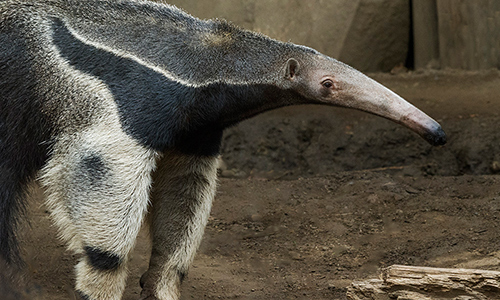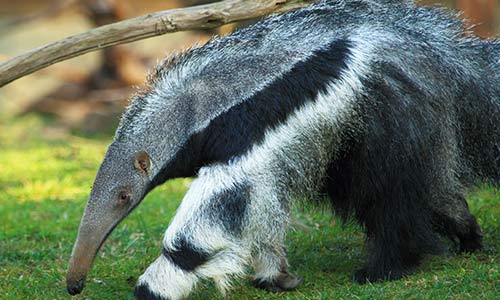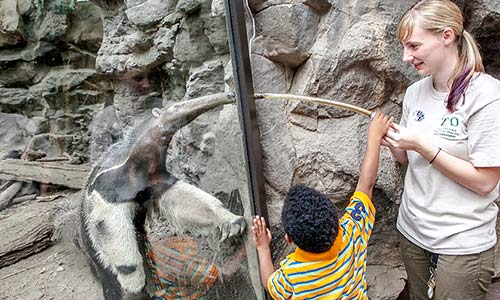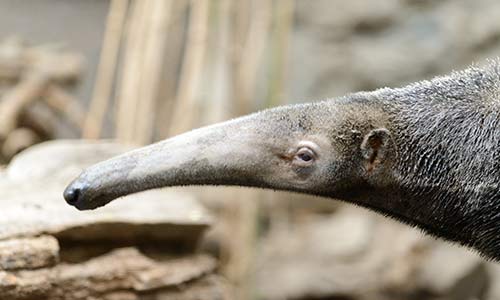Giant Anteater
Myrmecophaga tridactyla
About the Giant Anteater

Geographic Range:
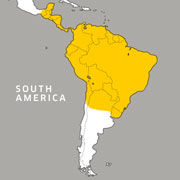
Class: Mammalia
Order: Pilosa
Family: Myrmecophagidae
Genus: Myrmecophaga
Species: tridactyla
The giant anteater has small eyes and ears, a long snout, and a bushy tail. It's typically brown with white and black stripes. Its tongue can elongate to approximately 2 feet in order to capture prey. The giant anteater is not aggressive, but when cornered it will defend itself with the 4-inch claws of its forepaws.
Committed to Conservation
Zoo New England participates in the giant anteater Species Survival Plan. By sharing research and knowledge, participating institutions work together to establish guidelines that best ensure the health of captive populations, and with success, the survival of endangered species.
You Can Help!
Giant anteater populations are threatened by habitat loss and fires often used to clear natural vegetation for crop plantations. One way you can help is by buying shade-grown coffee instead of sun-grown coffee. Shade-grown coffee utilizes trees and natural vegetation, rather than cleared land, and can be identified by a Bird Friendly label.


Anteater Facts
Appearance:
Giant anteaters are a relatively short animal with a long snout and bushy tail. They have small eyes and ears. They are a brownish grey except for a long triangular black patch from their chest to just behind their shoulder. A giant anteater's tongue is 2-feet-long and can flick in and out of its mouth 150 time per minute. They walk on their knuckles as to not harm their 4-inch claws.
Size:
Weight: 60-90 pounds; infants weigh about 3.5 pounds at birth
Length: Adults can reach from 6-8 feet from tip of the snout to end of the tail
Diet:
Anteaters feed mostly on ants, termites and grubs. A giant anteater uses its keen sense of smell to locate termite mounds and ant hills, and its long claws to crack the mounds open in search of prey. Using its long, thick, saliva-coated tongue, a single anteater can eat up to 35,000 insects per day. Anteaters never destroy an ant’s nest; this way they can return later to eat more.
Reproduction & Gestation:
Both males and females reach sexual maturity at 3-4 years of age. Anteaters' breeding season is usually between March and May, and they usually will breed once a year. After a 190-day gestation period, the female gives birth to one offspring. At birth, the infant has a full coat of hair and is almost identical to an adult. Since their coloration is similar, this provides camouflage for the offspring and added bulk to the mother. Anteater pups usually stay with the mother for first four weeks, climbing on her back when not nursing. A pup will be weaned at 6 to 9 months, leaving its mother when full grown, at around 2 years of age.
Behavior:
Giant anteaters are generally solitary animals, except for breeding and infant-care. They don't have permanent nesting or resting areas and will often wander throughout a range of 1 to 1.5 miles.
Most communication occurs between young and their mothers or during fighting, consisting of snorts, sniffs and hisses. Normally giant anteaters are not aggressive when they encounter one another. They usually ignore each other or run away, but when threatened they are fierce fighters. They will stand on their hind legs using their tail for balance and slash at the threat with their 4-inch claws. They sleep for around 15 hours a day in hollowed out depressions, using their long thick tail as a blanket. Giant anteaters are also good swimmers and will use their long snout like a snorkel.
Habitat/Range:
Giant anteaters are found in grasslands, swamps and forests in Central America from Southern Belize and Guatemala to Northern Argentina.
Median Life Expectancy:
Unknown in the wild
Threats in the Wild:
Known predators include jaguars and mountain lions. Habitat loss, being hunted for food or as pests, and the illegal pet trade are further threats.
How you can Help:
Practice smart ecotourism. When traveling, support organizations that support wildlife conservation and avoid purchasing products made from animals that could profit the wildlife trafficking and poaching industry. Share stories to raise awareness for this species.
Fun Facts:
- Anteaters’ body temperature is generally between 90 and 91 degrees Fahrenheit, one of the lowest of all placental mammals.
- The giant anteater has the longest tongue in relation to its body size of any mammal.
- Anteaters are most closely related to sloths and armadillos.
You Can Find This Animal in the Tropical Forest
Zoodopt an Anteater!
Zoodopts support the care and feeding of our animals, and with each purchase, we'll bring a little of the Zoo to you! Zoodopt today!
Tongue-tastic
The giant anteater has the longest tongue in relation to its body size of any mammal.
You might also like
At Franklin Park Zoo:
At Stone Zoo:

